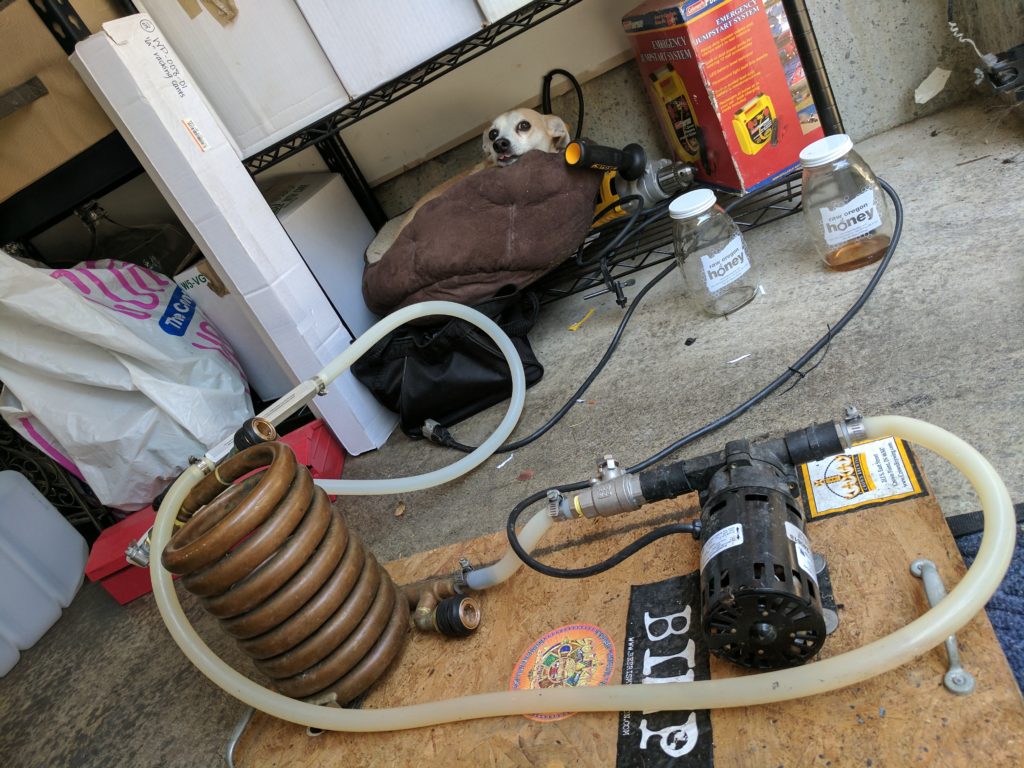I started brewing when I was 29, back in 1994. This was about 2 years after my wife and I got married. We’ll be celebrating our 25th wedding anniversary this year, which has been 23 of the best years of my life!…(and don’t tell Kim I said that!)
Back then, my LHBS was Great Fermentations in Indianapolis, located on 82nd street. I purchased a “Complete Homebrew Kit” for $39.99, a “Glenbrew 7# Irish Stout” kit for $22.49, a copy of “Complete Joy Of Homebrew” for $10.00, and a two page printout by GFI titled “Basic Brewing Instructions for the Beginner Using Hop Flavored Malt Extracts.” The receipt is dated one day before my 29th birthday, so it must have been my birthday present from my wife! So I went home and learned how to brew beer. In the early 90’s, our choices on ingredients and yeasts were not even close to what we have now. The internet wasn’t really available to the public yet, and I was brewing extract kits only. The recipes I got from GFI were printed out on dot-matrix printer paper, and yes, I still have every one of them! Most of them included liquid malt extract and dry yeast, and no telling how old that can of LME was that came over from England!
Of course back then I was bottling, and I was using bleach and water for all of my sanitizing because that’s what we did. For the first two years I brewed about every other month. Each time I did, I set back a six pack of brew I made for safe keeping. Then, I had a big beer party… I had about 4-5 cases of multiple flavors of six packs and I asked everybody that came to the party to bring a six pack of beer that they have never tried before. The reason was, none of my friends drank anything but “big beer”, so I wanted to expand everybody’s pallets a little bit. That party was a HUGE SUCCESS! I got rave reviews for my beers, and ended up the next day with a BUNCH of free beer in my fridge!
Over the next few years I slowed down a little bit, to a couple of batches a year. Then when we had kids, I went probably another two or three years without brewing. I know, nobody wants to admit it, but it happens to all of us.
The next few years I got back into it and brewed 2-3 batches a year. Then I started to get motivated again, and started brewing on a regular basis. At this point, I was probably 15 years into my brewing career. Keep in mind, I am still just brewing extract kits after all this time. I was really into the ease and convenience of kits, and I was brewing some very good beer. At least that’s what my friends told me when they came over to drink free beer! It wasn’t until a couple of years ago that I started brewing all grain. I know that most people get into all grain much sooner than that, but people need to know, you can can make some really good beer brewing extract beers! I happen to know several people who have won awards brewing extract kits in big competitions.
So, jump back to 2009. My wife and I started really enjoying drinking dry red wine, as well as beer. I had tried a few peoples homemade wines in the past, but they all sucked, so I wasn’t really that motivated to try making my own wine. Well, in 2009 we decided to go to Austria to visit distant cousins that we’d never met before. Turns out that we have two cousins that live in this little village in Austria that have commercial wineries, and we can even buy their wines here! After finding out that I came from a long line of winemakers, that motivated me to start making wine. So, I started researching on the internet. Turned out there was a HUGE amount of information out there, and there was a bunch of people out there actually making good wine. Who’d a thunk it?
My first wine I made was a honey mead wine. The recipe I used was “Joe’s Ancient Orange Mead.” It’s a very simple mead recipe using 3.5 pounds of honey protein gallon, one orange cut into quarters, one cinnamon stick, one whole clove, a handful of raisins, and a pinch of nutmeg. Mix it together, and add Flieschmanns bread yeast, and let it sit for two months without touching it. At two months it will clear and most of the fruit will drop out. (I know, you are thinking that’s just crazy talk using bread yeast, but it’s a tried and true recipe that been made millions of times successfully).
Even though I’ve never entered a single beer into a beer competition, I decided to enter this mead into the Indy International Wine Competition. I ended up winning Honey Wine Blend Of The Year 2010! I’m sure if the “mead aficionados” knew I made a mead with bread yeast they’d verbally crucify me! The next year, I started buying kit wines from Great Fermentations made by WineExpert. I started making a bunch of kit wines. I also started entering my wines in the Indy International. In 2011 I won Indiana Amateur Winemaker of the year! The next year, I got red wine juice from Easley Winery. I got some Chambourcin juice that was grown in southern Indiana, fermented it, and then did a malolactic fermentation on it, entered it, and won Indiana Grown Wine Of The Year! In a three or four year period I won about 30 medals, bronze, silver, gold, and even three Double Golds! Now, I usually buy about 30 gallons a year of fresh juice from GFI, ferment it, keg it, and keep it on tap with nitrogen.
I don’t think that the reason I won all these awards were some kind of magic mojo I have, I honestly believe that it is because I followed the directions and recipes EXATLY TO THE TEE! I made sure my fermentation temperatures were just right, my sanitation was perfect, my timing of racking, oak additions, malolactic Fermentations, etc., followed time tested schedules, and most of all, I TOOK MY TIME. It’s all about consistency. You don’t have to reinvent the wheel, just follow the dang directions!
Fast forward to last year, I decided to up my game! I built a single tier R.I.M.S. System brew stand. I now have a 15 gallon Spike HLT, a 15 gallon Spike MLT, and a 20 gallon Blichmann brew kettle. I’m now brewing 10-15 gallon batches, twice the amount of beer in the same amount of time! I now also use BeerSmith software for designing my recipes. It really has helped me get my recipes figured out, and helped me to brew consistently. The last thing I want to share is I have really started to get my brewing water totally dialed in. I purchase Primo Water for my brewing. It’s five gallon jugs of R.O. Water that has minerals added to it. I took a sample of my home city water, and a sample of the Primo Water, and sent them off to Ward Labs to be tested. My local water came back SO BAD, that it really can’t be used for brewing. It’s not that it’s contaminated, it’s that the Bicarbonate, HCO3 is 515 ppm, and the Total Alkalinity, CaCO3 is 426 ppm… way too high for brewing. So, I take those results from the water test, and I enter it into John Palmer’s water spread sheet, (free from his website), and it tells me exactly what I need to add to the water to get the BEST BEER for the style I’m making.
Needless to say, I am now making some pretty darn good beer. Just ask me!













 Let me start by introducing myself. My name is Erik Howell. I’m an Indianapolis native that recently moved to Portland, OR and have been brewing for just over 10 years. I love all forms of fermentation, and would consider myself a “maker/survivalist”. Haha. Sounds better than “doomsday prepper” doesn’t it? I first got introduced into craft beer in the early 2000’s when I was in college. There was a craft beer bar just down the street from my house called
Let me start by introducing myself. My name is Erik Howell. I’m an Indianapolis native that recently moved to Portland, OR and have been brewing for just over 10 years. I love all forms of fermentation, and would consider myself a “maker/survivalist”. Haha. Sounds better than “doomsday prepper” doesn’t it? I first got introduced into craft beer in the early 2000’s when I was in college. There was a craft beer bar just down the street from my house called 












